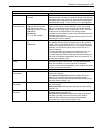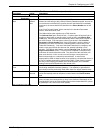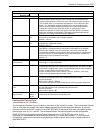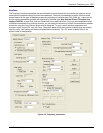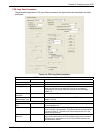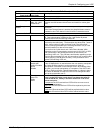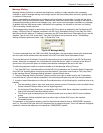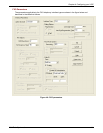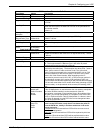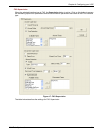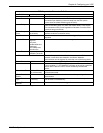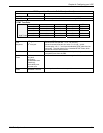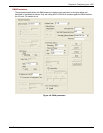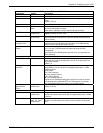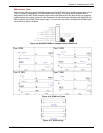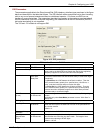
Chapter 4: Configuring your VOIP
Multi-Tech Systems, Inc. 45
FXO Interface: Parameter Definitions
Field Name
V
alues Description
Interface Type FXO Enables FXO functionality
Dialing Options
Regeneration Pulse, DTMF Determines whether digits generated and sent out will be pulse tones
or DTMF.
Inter Digit Timer 1 to 10 seconds This is the length of time that the MultiVOIP will wait between digits.
When the time expires, the MultiVOIP will look in the phonebook for
the number entered.
Default = 2.
Message Waiting
Indication
--
Not applicable to FXO interface
Inter Digit
Regeneration Time
50 to 20,000
milliseconds
The length of time between the outputting of DTMF digits.
Default = 100 ms.
FXO Options
FXO Ring Count 1-99 Number of rings required before the MultiVOIP answers the incoming
call.
No Response
Timer
1 – 65535
(in seconds)
Length of time before call connection attempt is abandoned.
Flash Hook Options fields
Generation 50 - 1500
milliseconds
Length of flash hook that will be generated and sent out when the
remote end initiates a flash hook and it is regenerated locally. Default
= 600 ms.
Detection Range
--
Not applicable to FXO.
Caller ID fields
Caller ID Type Bellcore The MultiVOIP currently supports only one implementation of Caller
ID. That implementation is Bellcore type 1 with caller ID placed
between the first and second rings of the call.
Caller ID enable Y/N Caller ID information is a description of the remote calling party
received by the called party. The description has three parts: name of
caller, phone number of caller, and time of call. The ‘time-of-call’
portion is always generated by the receiving MultiVOIP unit (on FXS
channel) based on its date and time setup. The forms of the ‘Caller
Name’ and ‘Caller Phone Number’ differ depending on the IP
transmission protocol used (H.323, SIP, or SPP) and upon entries in
the phonebook screens of the remote (CID generating) VOIP unit.
The CID Name and Number appearing on the phone at the terminating
FXS end will come either from a central office switch (showing a PSTN
phone number), or the phonebook of the remote (CID sending) VOIP
unit.
CID Manipulation Enabled by
default with
Caller ID enable
above
Disable
This is not implemented in the –SS series VOIPs.
Caller ID Manipulation is used whenever the user wants to manipulate
the Caller ID before sending it to the remote end. Caller ID
Manipulation is activated on the Interface Screen. By enabling Caller
ID option, you can set manipulation to Transparent, User CID, Prefix,
Suffix, or Prefix and Suffix. Caller ID Manipulation is a feature, where
the Caller ID detected from the PSTN line can be changed and then
sent to the remote side over IP.
CID Mode Transparent,
User CID,
Prefix,
Suffix
The MultiVOIP is not allowed to modify the caller ID info and then
send it to the PSTN side. It only allows it to detect the caller ID
from the PSTN line, modify it and then send them via IP to the
remote end point.
Transparent
: the CID received from PSTN will be sent out as such,
without any manipulation.
User CID: the CID received from PSTN will be replaced by this User
CID value.
Prefix:
the CID received from PSTN will be prefixed with this value.
Suffix
: the CID received from PSTN will be suffixed with this value.



